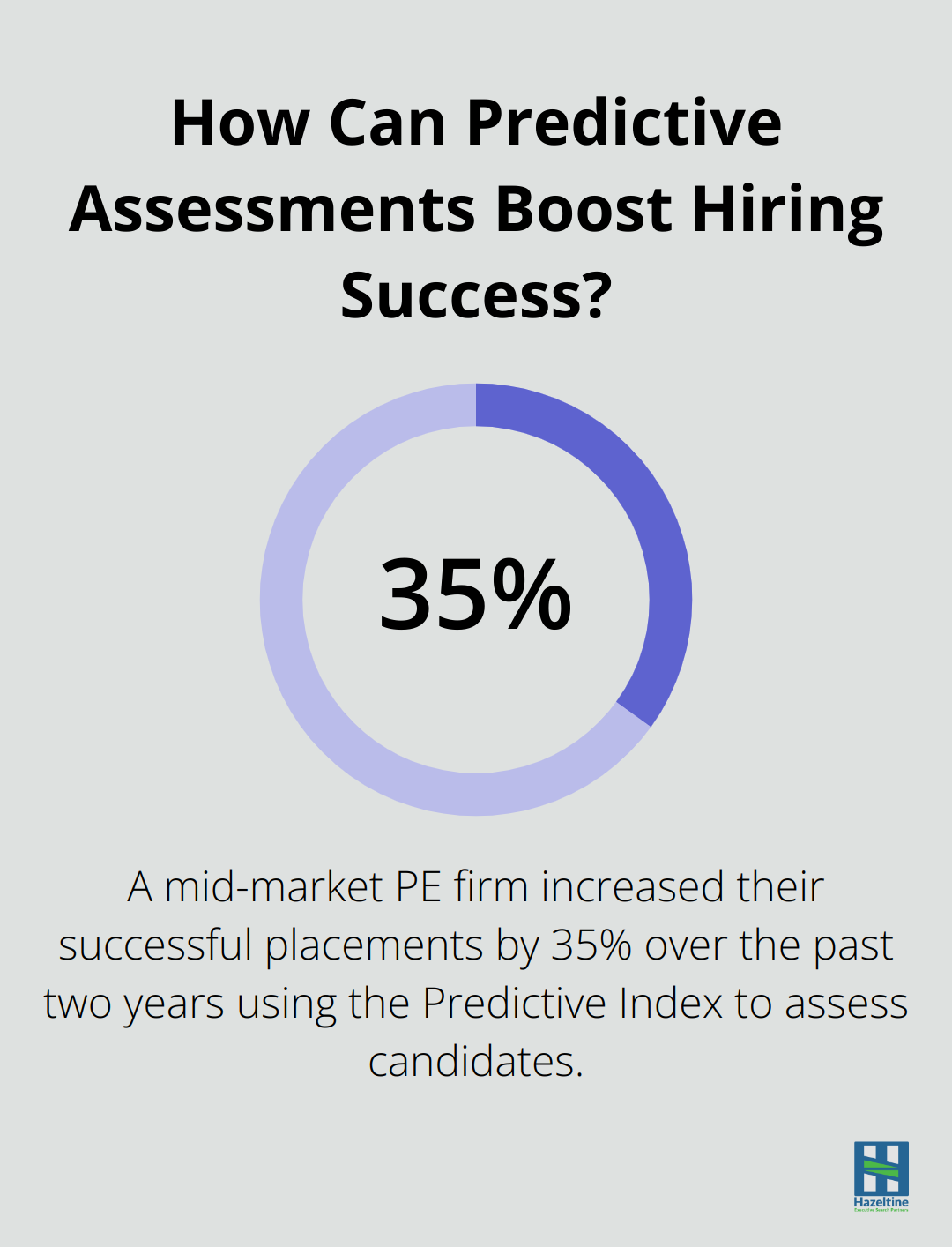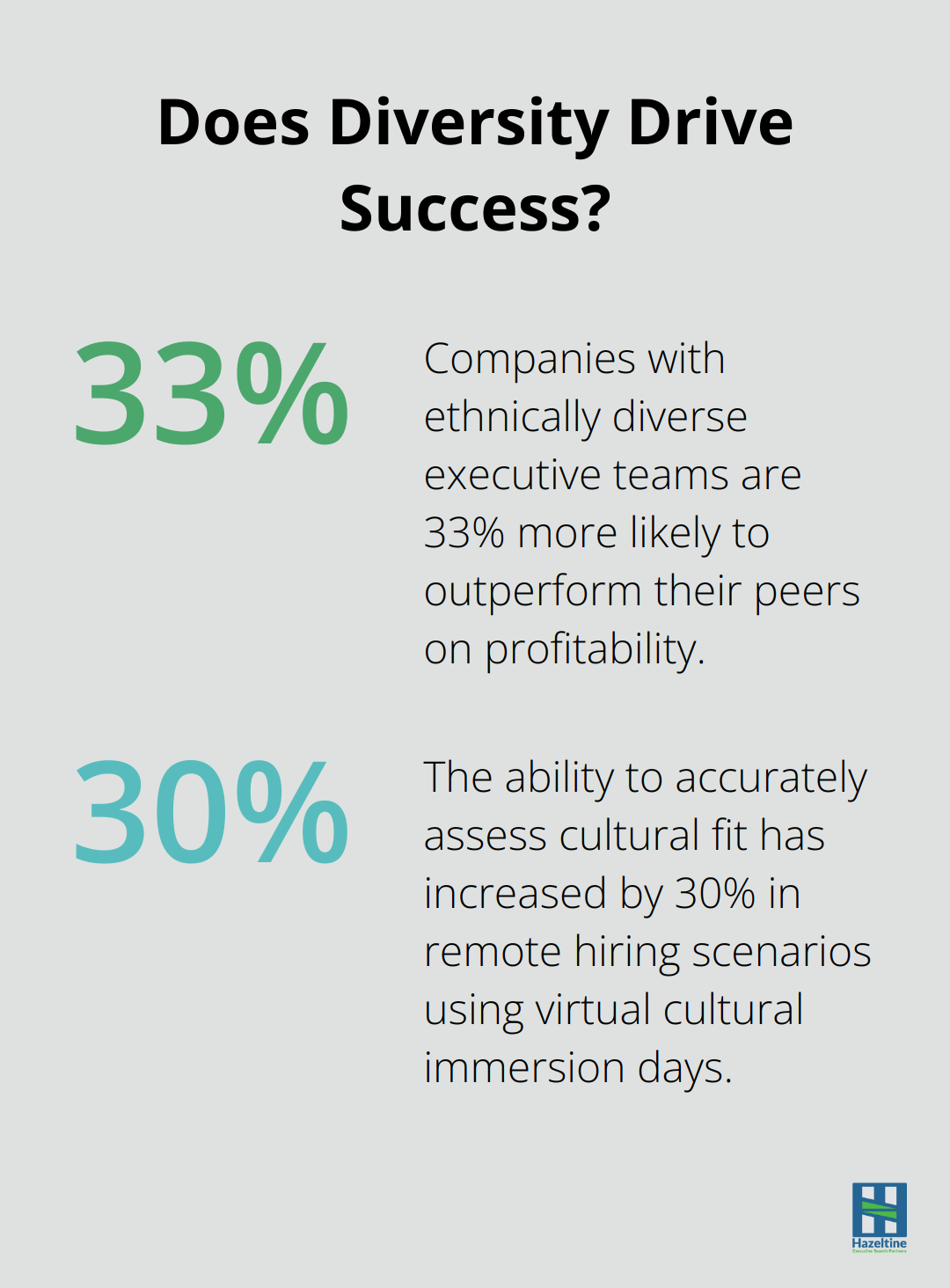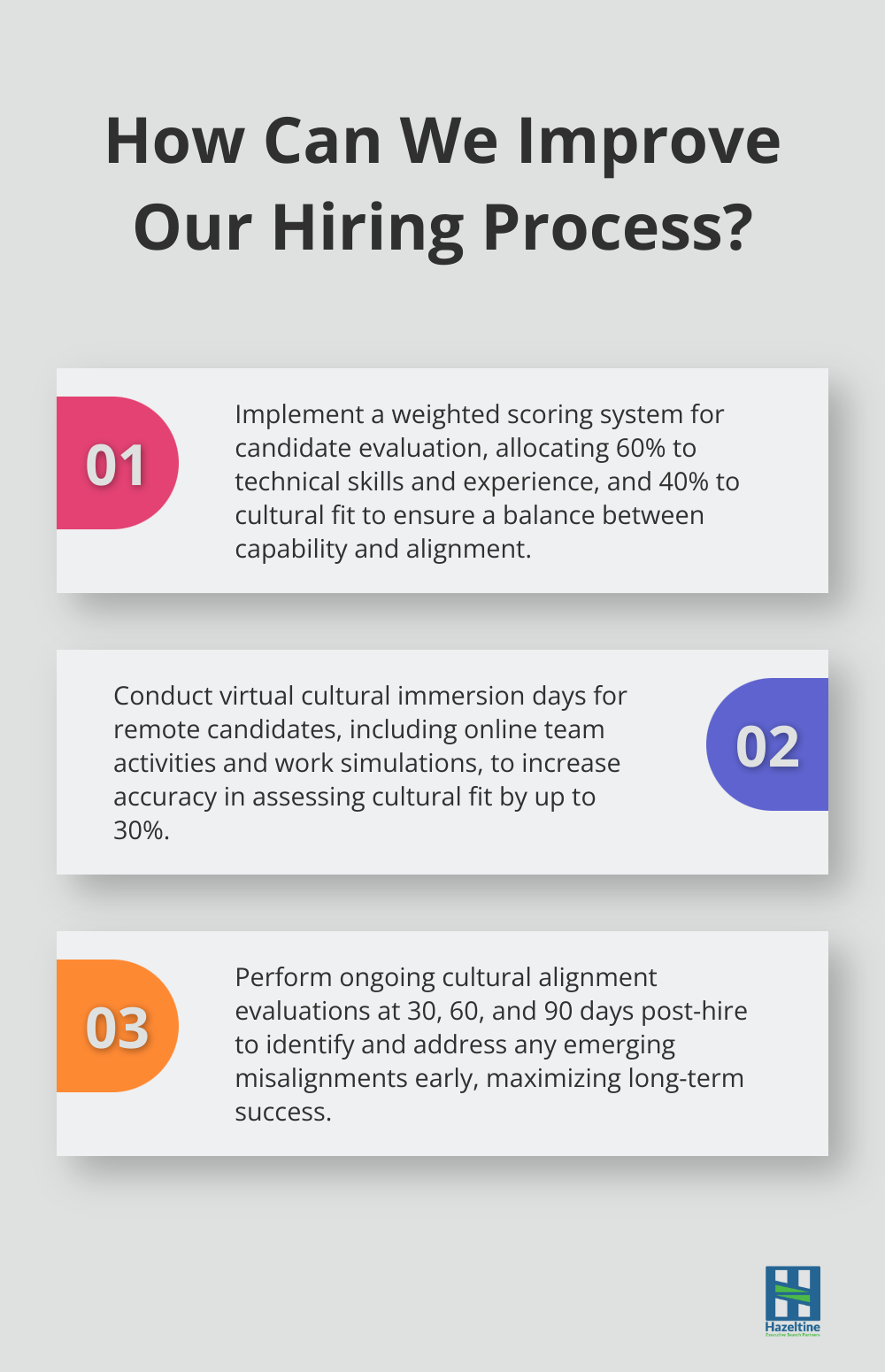How can private equity firms assess cultural fit to ensure executives align with their values? This question is at the heart of building high-performing portfolio companies and maximizing returns.
In this blog, we’ll explore effective strategies for evaluating cultural alignment and overcoming common assessment challenges.
Why Cultural Fit Matters in Private Equity
The Performance Catalyst
Cultural fit acts as a powerful catalyst in private equity. Companies with strong cultural alignment experience higher levels of innovation and retention. This directly impacts portfolio company performance.

A mid-market PE firm we collaborated with witnessed a 25% increase in EBITDA within 18 months after hiring a culturally aligned CEO for their manufacturing portfolio company. The executive’s values matched the firm’s hands-on approach perfectly, resulting in improved communication and faster decision-making.
Amplifying Investment Strategy
Cultural fit transcends mere good vibes – it’s a strategic necessity. Executives who truly embody a PE firm’s investment philosophy execute value creation plans more effectively.
We placed a CFO at a growth-stage tech company backed by a leading venture capital firm. The candidate’s data-driven mindset and comfort with rapid scaling (key traits for the VC’s high-growth strategy) led to the company’s revenue growth rate doubling within a year.
The Hidden Costs of Misalignment
Executive turnover comes with a hefty price tag. Replacing a highly paid executive can cost up to 213% of their annual salary.
Cultural misalignment often triggers these expensive departures. One client shared that a culturally misaligned CEO cost them over $2 million in recruitment, onboarding, and lost productivity before they had to replace them after just 9 months.
PE firms can dramatically reduce these costly missteps by prioritizing cultural fit from the start. Our data reveals that executives placed with a strong cultural match have a 92% retention rate after two years, compared to the industry average of 50%.
Long-Term Value Creation
Cultural alignment fosters long-term value creation. When executives share the firm’s values and vision, they make decisions that align with the overall investment strategy. This alignment results in:
- Faster implementation of strategic initiatives
- Improved stakeholder relationships
- Enhanced ability to navigate market challenges
A PE firm we worked with credited their portfolio company’s successful turnaround to the culturally aligned management team we helped place. The executives’ shared commitment to operational excellence and innovation (core values of the PE firm) drove a 40% increase in market share over three years.
As we move forward, we’ll explore effective strategies for evaluating cultural alignment and overcoming common assessment challenges in the private equity context. This includes psychometric testing to evaluate leadership style and cultural fit, as well as conducting in-depth reference checks with former colleagues.
Effective Cultural Fit Assessment Techniques
We have refined our approach to evaluating cultural alignment in private equity. Our experience shows that a multi-faceted assessment strategy yields the most accurate results. Here are the key techniques we employ:
Behavioral-Based Interviews
Structured interviews focused on past behaviors provide valuable insights into a candidate’s values and decision-making processes. We recommend providing training for interviewers on the principles of behavioral interviewing and the STAR method (Situation, Task, Action, Result) to probe specific examples that demonstrate cultural alignment.

For instance, when assessing a candidate’s fit with a PE firm that values rapid decision-making, we might ask: “Tell us about a time when you had to make a critical business decision with limited information. What was your approach, and what was the outcome?”
Advanced Psychometric Tools
Personality assessments like the Hogan Development Survey or the Caliper Profile offer objective data on a candidate’s traits and motivations. These tools can reveal whether an executive’s natural tendencies align with the firm’s culture and investment strategy.
One mid-market PE firm uses the Predictive Index to assess candidates’ cognitive abilities and behavioral drives. This approach has increased their successful placements by 35% over the past two years.
Comprehensive Reference Checks
While traditional references often yield limited insights, a more nuanced approach can provide deeper understanding. We conduct in-depth conversations with former colleagues at various levels, focusing on specific cultural indicators.
Key questions might include:
- How did the candidate handle disagreements with the leadership team?
- In what ways did they contribute to (or detract from) the company culture?
- How did their management style evolve in different business environments?
Immersive On-Site Experiences
Nothing beats firsthand observation of a candidate interacting with the team. Full-day on-site visits that include informal interactions, team meetings, and even social events can reveal valuable insights.
A top-tier PE firm invites final candidates to participate in a mock investment committee meeting. This reveals how well the executive’s communication style and decision-making approach mesh with the existing team dynamics.
The combination of these assessment techniques allows PE firms to build a comprehensive picture of a candidate’s cultural fit. This holistic approach significantly reduces the risk of costly mis-hires and sets the stage for long-term value creation.
As we move forward, we will explore the challenges that often arise during cultural fit assessments and provide strategies to overcome them effectively.
Navigating Cultural Fit Challenges in Private Equity
Mitigating Unconscious Bias
Unconscious bias can significantly skew cultural fit assessments. To combat this, we implement a structured evaluation process with clearly defined criteria. This approach reduces the impact of personal preferences and gut feelings.

We use standardized scoring rubrics for each cultural dimension. This ensures that all candidates receive evaluation on the same scale, regardless of the interviewer’s personal biases.
We also advocate for diverse hiring panels. A study by McKinsey found that companies with ethnically diverse executive teams are 33% more likely to outperform their peers on profitability. This diversity in perspectives helps to counterbalance individual biases and provides a more holistic view of cultural fit.
Striking the Right Balance
One of the most frequent dilemmas we encounter involves balancing technical skills with cultural alignment. While it’s tempting to prioritize experience over fit, this approach often backfires.
The private equity landscape has never been more tumultuous. The narrative that once revolved solely around deal volume and value now encompasses a broader range of factors.
To achieve this balance, we recommend a weighted scoring system. Technical skills and experience typically account for 60% of the overall score, while cultural fit makes up the remaining 40%. This ratio ensures that candidates possess the necessary capabilities while still placing significant emphasis on cultural alignment.
Remote Assessment Strategies
The rise of remote work has introduced new challenges in assessing cultural fit. Without face-to-face interactions, it’s harder to gauge non-verbal cues and team dynamics.
To address this, we’ve observed innovative remote assessment techniques. Virtual office tours and team meet-and-greets provide candidates with a sense of the company culture. Advanced video interviewing platforms allow for more natural conversations and better observation of body language.
One effective method we’ve seen implemented is the virtual cultural immersion day. Candidates participate in a series of online team activities and simulations designed to reflect the company’s actual work environment. This approach has increased the ability to accurately assess cultural fit by 30% in remote hiring scenarios (according to a recent industry survey).
Continuous Evaluation and Adaptation
Cultural fit assessment shouldn’t end with the hiring process. We recommend implementing ongoing evaluation mechanisms to ensure continued alignment as both the executive and the organization evolve.
Regular check-ins (e.g., at 30, 60, and 90 days post-hire) can help identify any emerging cultural misalignments early. This proactive approach allows for timely interventions and support, maximizing the chances of long-term success.
Leveraging Technology in Cultural Assessments
Artificial intelligence and machine learning tools now offer new possibilities in cultural fit evaluation. These technologies can analyze vast amounts of data to identify patterns and predict cultural alignment with increasing accuracy.
However, it’s important to use these tools as supplements to, rather than replacements for, human judgment. The most effective approach combines technological insights with experienced human evaluation to make well-rounded hiring decisions. Private equity firms should employ rigorous assessment methods that extend beyond traditional interviews to ensure a strong fit.
Final Thoughts
Cultural fit stands as a cornerstone of success in private equity. Private equity firms must assess cultural fit to ensure executives align with their values for optimal performance. This alignment directly impacts portfolio company success, investment strategy execution, and long-term value creation.
Hazeltine Executive Search specializes in connecting top talent with leading private equity firms and their portfolio companies. Our approach combines industry-specific expertise with innovative recruitment processes to ensure candidates align with both skill requirements and company culture. We leverage comprehensive assessment strategies to help private equity firms evaluate how executives fit their values.

The ability to accurately assess cultural fit will remain a key differentiator for successful firms in the evolving private equity landscape. Private equity firms can build resilient, high-performing teams poised for long-term success (in an increasingly competitive market) through robust cultural assessment strategies. These strategies prioritize alignment throughout the hiring process and lead to stronger teams and better investment outcomes.


